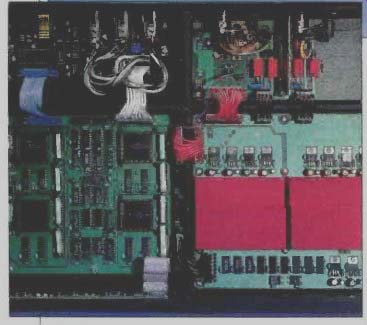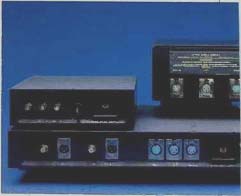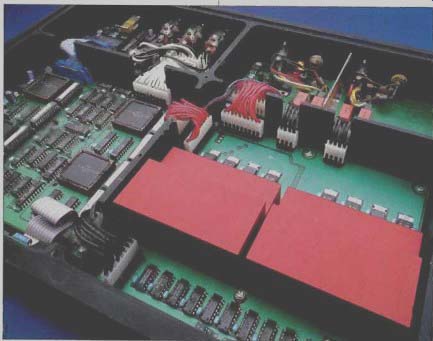PARLEZ-VOUS "FRENCHCURVE"?

By now, five years since the introduction of the Compact Disc format, most audiophiles have become fairly conversant with the arcane world of digital audio. Many have had CD players since their inception, and have become familiar with their idiosyncrasies. They have watched the gradual evolvement of CD players from the most basic, straightforward Sony and Philips designs, to the elaborations and advances found in current players.



Audiophiles have become either CD believers or digiphobes who steadfastly continue their love affair with the analog vinyl record. The cause of this schism is the ongoing difference of opinion about the sonic qualities of CD reproduction. The believers feel that the Compact Disc, with its wide frequency and dynamic range, absence of noise, low distortion, and lack of wear, is a sonically accurate medium for the storage and reproduction of music. They will concede that they can hear differences between various CD players, and that such things as over-sampling and digital filters make current players sound better than their predecessors. These believers also feel strongly that the alleged sonic artifacts digiphobes claim to hear are more the consequences of recording techniques than of anything else.
The digiphobes, on the other hand, maintain that CD sound is unmusical, sterile, and clinical; that ambience and reverberation are truncated and attenuated, and that they can hear "digital glare" and high-frequency hash generated by so-called "brick-wall" filtering.
It is not a question of choosing sides in this sort of debate. Too many factors are involved which haven't been ad dressed. It is a matter of individual aural acuity and perception, as well as acoustic environment, type and quality of equipment, choice of program material, and even psychoacoustic conditioning. It also is a matter of degree: An artifact which makes one listener cringe may be of little moment to another.
Looking at the issue less emotionally, there are new scientific methodologies which can be implemented in the measurement of digital audio phenomena. In turn, these measurements can be related back to aural perceptions. It now appears that, in CD playback, some sonic artifacts are not illusory, but in fact can be detected and quantified. In various ways, considerable progress has been made in eliminating and suppressing some of these sonic artifacts.
In my Chicago SCES report (September 1988), I noted the debut of the Wadia 2000 Digital Decoding Computer and promised a detailed report. I finally have a production version of this breakthrough device, and as you will learn, it is one of the most technologically sophisticated digital products now on the market.
Unlike most outboard D/A converters, the Wadia 2000 is indeed a digital decoding computer of rather exceptional power. The complete system consists of a separate power supply, an optical interface unit, and the main decoder/computer.
The power supply has independent transformers, rectifiers, filters, and triple-stage regulation for the left and right analog channels. There also are three power supplies for digital circuitry, with such features as linear regulators and proprietary, high-frequency, power-rail filters.
A unique feature of the Wadia 2000 is its DigiLink 30 fiber-optic communicator. This unit accepts 75-ohm digital coaxial outputs from 32-kHz satellite broadcasts (when available), 44.1 kHz from CD, and 48 kHz from R-DAT. The three input formats are switch-select able on the front panel. Obviously, a CD or R-DAT player must have a coaxial digital output port to be connected to the DigiLink unit. The digital signals from these ports will have undergone CIRC (cross-interleave Reed-Solomon code) error correction, but bypassed the player's D/A converters, filters, and all analog circuitry. In other words, the CD player is basically acting as a turn table. In the DigiLink, the digital signals are converted to optical signals. Then a gallium aluminum arsenide laser (the same as that used in the CD player to track the information pits on the CD), drives the optical signals through a precision lens assembly and into professional-quality, 62.5-micron, glass fiber-optic cable. This cable is used as the transmission medium from the remotely located DigiLink to the decoder/computer. Fifty feet of cable is sup plied with each Wadia 2000, although in special applications, up to three kilo meters could be used without signal loss! This fiber-optic cable is a high performance link for data rates up to 50 megabits per second.
In the optical receiver of the decoder, incoming signals pass through another lens and into a PIN photodiode.
No provision is made for using the existing optical outputs of CD players for direct connection to the decoder, be cause plastic fiber is used, driven by weak LEDs, and this could degrade waveform purity. Nor is direct connection of the CD player's coaxial output to the decoder possible, as this would cause about a 15-dB loss in S/N ratio and poorer common-mode rejection.
The decoder/computer enclosure is made of heavy, machine-tooled, black anodized aluminum, with internal machined compartments for various circuit components. The front panel has a mode switch for on/standby and an invert switch for phase inversion in the digital domain. There are LED indicators for mode, de-emphasis, optical signal reception, and sampling rate (32, 44.1, and 48 kHz). The rear panel has the fiber-optic input, gold-plated Tiffany RCA jacks for unbalanced out put, and XLR outputs for balanced operation.
The decoder's optical receiver section, in addition to the photodiode, has a phase-locked loop which locks up to the master clock. Once the sampling rate of the incoming data has been determined to be either 32, 44.1, or 48 kHz, the clock signals are regenerated for these frequencies. The master clock introduces no phase distortion or noise, and jitter has been totally stripped away. The same area in the 2000 has a format decoder which looks for the AES/EBU input format.
However, there is provision for interchangeable chips to permit other for mats. Another compartment houses the CPU (central processing unit), which really is the heart of this device.
The CPU uses four, AT&T, digital signal-processing chips (the fastest DSP chips available) which operate in parallel at 36 MHz. These four chips generate over 72 million instructions per second, which is equivalent to 100 IBM personal computers! Calculations are performed in 36-bit mathematics, and eight high-speed EPROMs (electronically programmable read-only-memory) hold the decoder's software. The EPROMs are used two to a DSP chip one for low byte, one for high byte and are mounted in sockets so they may be interchanged with other de coding programs. Each Wadia 2000 is supplied with EPROMs containing the company's proprietary "Frenchcurve" time-domain, curve-matching algorithm. (Now that's quite a mouthful!) The system sounds complex, and it is, but this non-filter approach to digital decoding is the alternative to frequency-domain brick-wall filtering, with its pass-band ripple, overshoot, inter-transient ringing, and other artifacts. It is this sophisticated, time-domain soft ware that is largely responsible for the dramatically superior sound of CDs and R-DATs reproduced through the Wadia 2000.
I'm sure you are aware that a number of separate, outboard D/A converters for use with CD or R-DAT machines are on the market, from companies such as Sony, Denon, and Marantz. All of these units, and all CD and R-DAT players, process digital information through analog and digital filters whose characteristics are optimized in the frequency domain.
Now consider this: If one could ideally sample an analog signal (observing all aspects of the Nyquist sampling theorem), the original signal could be recovered from the discrete samples by means of an accurate D/A converter and an ideal low-pass filter. Unfortunately, achieving ideal sampling and building an ideal low-pass filter are impossible. Thus, the decoder must accept the non-ideal music samples as they were recorded. Any ripple in the filter pass-band directly causes distortion in complex music signals. Of course, if the roll-off is really steep-as in the 90-dB "brick-wall" filters of first-generation CD players-the high-frequency spuriae produced will appear in the music signals. In any real-world system, there is simply no getting away from them.
It is important to remember that in the earliest CD players, the notorious brick-wall was an analog filter. There wasn't even double oversampling, let alone four-times or the eight-times oversampling of some current players.
However, it must be noted that, contrary to the notions of many people, brick-wall filtering still exists. True, many CD players now use linear-phase digital filters, with four- to eight-
times oversampling, before the D/A converters; then the analog output filter can be relatively simple, permitting a fairly gentle roll-off slope. Using this arrangement, high-frequency spuriae at 24.1 kHz, when viewed on an oscilloscope, are reassuringly almost non existent. Where, then, is the brick-wall filter? It is none other than the digital filter.
Even though it is linear phase and is four to eight times oversampled, the roll-off is decidedly steep and "brick-wall" in its characteristics. A brick-wall digital filter has excellent frequency-domain specifications when driven by constant-energy sinusoids and white-noise test signals. Unfortunately, the transients and impulses of dynamic music signals cause it to generate overshoot, ripple, and ringing.
If one could employ as high as 64-times oversampling, this would push the noise bands above 2 MHz, where they would clearly be out of the music spectrum. Many technical constraints, however, make it extremely difficult, if not completely impractical, to use such high oversampling with a digital filter.
Problems with clock rates and with ac curacy abound.
The Wadia 2000 Digital Decoding Computer addresses this problem by eliminating the filter approach altogether. High-rate 64-times oversampling is achieved by a software program that provides the Frenchcurve computer algorithm, which is optimized for the time domain rather than the frequency domain.
The computer takes in either 44,100 or 48,000 samples per second for each channel. The Frenchcurve algorithm then implements a 12th-order, polynomial, mathematical function to fit the contours of 13 original samples at a time. Each set of 13 samples is advanced one at a time, to describe a smooth curve. As each new sample set arrives, the whole curve is redrawn while one of the "old" sample sets is dropped off. The entire sequence yields The equivalent of 64-times oversampling, but without the interpolation errors associated with frequency-domain oversampling methods. This tremendous number crunching is why the Wadia computer must perform 72 mil lion calculations per second. The original waveform, now a mathematical function, is re-sampled 2,822,400 times per second for CD and 3,072,000 times per second for R-DAT (64 times their original sampling rates).
The signals then are sent through the D/A converters. And it is here that the truly innovative work comes fully to the foreground.
According to a paper presented at the 1988 Paris AES Convention by Professor Stanley Lipshitz, president-elect of the Audio Engineering Society and an acknowledged expert on digital audio, "The single most important component in determining sound quality is the D/A converter." Which leads us to the rather special D/A converters in the Wadia 2000. They are fairly large modules, each housed in a single machined aluminum block. (As you know, normal D/A converters are small IC chips.) The Wadia D/As, a proprietary design of their own manufacture, are 18-bit linear, transversal, summed-multiport, digital-delay line types and feature a perfectly rectangular impulse response. Operationally, rectangular pulses are run down the delay line; at the ports along the line, these pulses are summed together to accumulate the number of pulses necessary to achieve the desired voltage. These D/As operate at very high speed, since the pulses travel down the delay line at microwave velocity and the multiple ports provide near-instantaneous buildup to the required voltage. They therefore eliminate the need for "de-glitching" and sample-and-hold circuitry, thereby neatly avoiding the sonic colorations associated with the di electric memory of capacitor-dependent circuitry.
After D/A conversion, the balanced and unbalanced outputs of the converters are routed directly to the output connectors without buffering or other intervening analog circuitry (except for automatic passive de-emphasis, which is applied only if the source was re corded with pre-emphasis).
As most readers know, dither signals are applied in digital recording to re duce low-level distortion and to ensure resolution down to the least significant bit (LSB). Some of the very earliest CDs were made on digital recorders without dither, which caused some attenuation of reverberation and ambience. This artifact was gleefully pounced on by digiphobes, many of whom believe this anomaly still exists in current recordings.
Dither is not generally applicable to CD playback, but in the Wadia 2000, dither is used in rounding off the 36-bit numbers. This minimizes round-off error and LSB bias. In the same 1988 AES paper, the redoubtable Professor Lipshitz had an interesting comment on dither: "Most two- or four-times oversampling digital filters in CD players appear to use simple, numerical two's-complement truncation to re-quantize their internal word lengths to the desired output word length. In fact, although properly digitally dithered rounding is the only way to fully re move quantization artifacts contributed by the filter arithmetic, it appears not to in any of the designs so far available, perhaps because of the attendant slight increase in the noise floor. Nevertheless, only by properly dithering such digital operations will the potential for audible quantization distortions be eliminated." To support the technical complexity of its design, the Wadia 2000 uses premium parts as well as construction practices of the highest quality. For example, included are elaborate, 11-layer Mil-spec p.c. boards. These contain six layers of circuitry, ground planes and massive power planes, which are separated by five glass-epoxy layers of various thicknesses to optimize wide-band trace impedances. As a result, the Wadia occupies a relatively small space for such a powerful computer. Since it is modular in construction, the unit can be up graded or expanded to accept new technology. For example, if 32-bit digital recording becomes available, the Wadia D/As are readily upgradable.
Obviously, the Wadia 2000 Decoding Computer is a technical tour de force. As always, the question is: How does it perform and how does it benefit CD and R-DAT playback? I hooked up the 2000 to the 75-ohm coaxial outputs from a Sony CDP 707ESD Compact Disc player and a Sony DTC-1000ES R-DAT player. I used the balanced XLR outputs of the 2000 to feed into balanced inputs on the Cello Audio Suite, thence to Cello Performance amplifiers and Duntech Sovereign speakers. I then had quite a few prominent recording engineers, from both the classical and the pop fields, audition the Wadia 2000 in my home. These fellows listened to CDs they had engineered, and they knew exactly where they had positioned their microphones and how they had made their recordings. All were unanimous in stating that what they heard through the Wadia 2000 was what they had heard through the microphone inputs! They marveled at the cleanness and purity of the music signals, the incredible resolution (even in the lowest-level passages), and the extension, solidity, and weight of bass response. They were impressed by the instantaneous transient attack, especially on percussion and piano. Most remarkable of all-and particularly noted by the classical-music engineers-was the presentation and retrieval of hall ambience, the preservation and natural de cay of reverberation, and the wide soundstage and huge depth, with layered front-to-back perspectives. I completely concur with their knowledgeable observations.
Again, it is a matter of degree. Prior to using the Wadia 2000, I felt that I was getting really outstanding CD and R-DAT reproduction from the current, state-of-the-art Sony players. With all due respect to the competition, the Wadia 2000 simply revealed musical vistas and all sorts of little nuances and details that had previously gone unnoticed. The Wadia enables you to "see" more deeply into the music; above all, the sense of ambience and the illusion of immersion in a concert hall is emotionally involving.
I've already experienced rabid, anti-digital people who, after listening to CDs played on the Wadia 2000, were rather unnerved and nonplused be cause the digital artifacts which they loved to rant about simply were not audible. I have no doubt that the compact Disc will win many converts with the availability of this system.
The Wadia 2000 even has professional applications that bode well for CD and even vinyl records. Because it has the AES/EBU input format, the unit can accept output from any professional digital recorder and then feed its balanced outputs into disc-cutting amplifiers or CD-cutting lasers.
As usual, a product as technically advanced as the Wadia 2000 Digital Decoding Computer is not inexpensive. It will sell for $6,500 and should be available in select, high-end dealers as you read this. The Wadia 2000 is manufactured in America by Wadia Digital Corp., a division of Medea Ltd. in Minneapolis, Minn., which has an extensive background in many aspects of digital technology.
(adapted from Audio magazine, Oct. 1988; Bert Whyte)
= = = =